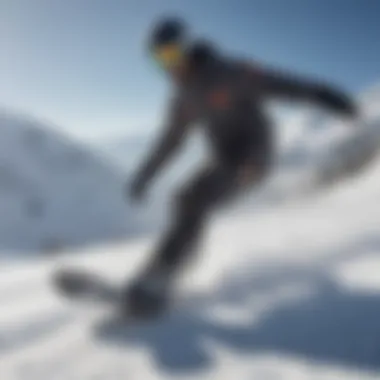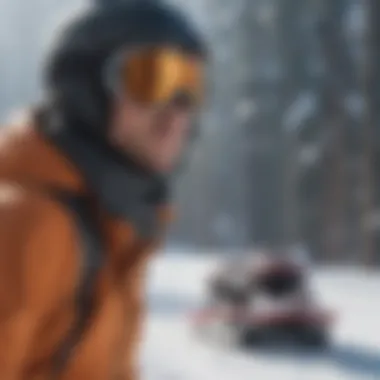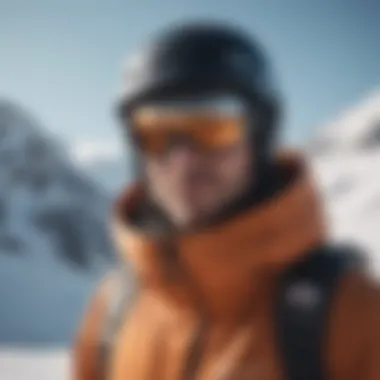Beginner's Guide to Snowboarding: Essential Tips


Extreme Sport Overview
Snowboarding is not just a sport; it’s a lifestyle that attracts millions of enthusiasts around the world. As a winter extreme sport, it involves descending snow-covered slopes on a snowboard. This board is wider and has a unique design compared to skis, allowing for a different style and technique of riding.
Brief History of the Sport
Snowboarding emerged in the late 1960s, with innovators like Sherman Poppen, who created the first snowboard by combining a ski and a snowboard. The sport gained traction in the 1980s and 1990s and made its Olympic debut in 1998 during the Nagano games. Over the years, snowboarding has evolved significantly, diversifying into various styles, including freestyle, alpine, and backcountry.
Equipment Required
For a beginner, selecting the right equipment is paramount. Here’s a summary of what is typically required:
- Snowboard
- Bindings
- Boots
- Safety Gear (helmets, padding)
- Appropriate Clothing (waterproof jackets, pants)
Safety Tips and Guidelines
Finding balance on a snowboard requires practice and awareness of one’s surroundings. Always consider these safety guidelines:
- Use a helmet to protect your head.
- Learning on beginner slopes is advisable.
- Stay within your skill level to avoid accidents.
- Be mindful of other snowboarders and skiers.
Relevant Statistics and Facts
Snowboarding has gained popularity rapidly. In the USA alone, about 7.5 million individuals participated in snowboarding during the 2018-2019 season. Additionally, studies suggest that proper training and experience can significantly lower the risk of injury.
"Snowboarding combines athleticism, skill, and thrill, making it one of the most popular winter sports today."
Next, it is essential for beginners to familiarize themselves with the techniques and training needed to excel in snowboarding.
Prologue to Snowboarding
Snowboarding is not just a sport; it is a complex blend of art, technique, and adventure. Understanding the fundamentals of snowboarding is crucial for beginners. This section sets the stage for everything that follows. By grasping the basics, newcomers will navigate through the thrill of riding slops with more confidence and safety.
It is essential to comprehend what snowboarding entails. This comprehensive guide will list the required equipment, outline important safety measures, and touch on cultural aspects of snowboarding, ensuring you are well informed.
Overview of Snowboarding
Snowboarding originated in the 1960s and has rapidly evolved into a global phenomenon. It merges elements of skiing and surfing, offering a unique experience on snow-covered terrains. In addition to freestyle and alpine styles, snowboarding encompasses various forms of riding, from park features to backcountry adventures.
Each style demands specific skills and equipment, giving enthusiasts a choice that suits their personal preferences.
The importance of snowboarding lies in its ability to connect individuals with nature and foster a sense of community. The thrill gained from mastering various techniques is unmatched, making every ride an opportunity for personal growth.
History and Evolution
The history of snowboarding is rich and diverse. In its early days, it was seen as a fringe activity, often met with skepticism from traditional skiers. The invention of the first snowboard, the "Snurfer," in the 1960s was a pivotal moment.
As the years progressed, manufacturers began refining designs. The introduction of bindings revolutionized the sport, allowing riders to secure their feet to the board.
By the 1980s, snowboarding gained mainstream acceptance. Events like the Winter X Games showcased the sport’s evolution. Today, snowboarding is recognized on global platforms, even making its way into the Winter Olympics. The cultural significance cannot be understated, as snowboarding continues to inspire new generations to hit the slopes.
In summary, understanding snowboarding is vital for newcomers to experience the sport fully. An appreciation of its history enhances the rider’s connection to the slopes.
Understanding Snowboard Equipment
Understanding snowboard equipment is crucial for both safety and performance on the slopes. Proper gear enhances your experience, allowing for better control, comfort, and enjoyment. Each piece of equipment plays a significant role in how you ride and can affect your learning curve dramatically.
Choosing the Right Snowboard
When selecting a snowboard, consider your skill level, riding style, and the types of terrain you prefer. Beginners typically benefit from an all-mountain snowboard. These boards are versatile, making them suitable for various conditions. Pay attention to the board's length, width, and flex. A shorter board can enhance maneuverability, while a wider board offers stability on powder.
- Length: Look for a board that reaches somewhere between your chin and nose when stood on end.
- Width: Ensure your feet fit comfortably without overhang, particularly if you have larger feet.
- Flex: Softer boards are often more forgiving, making them excellent for those just starting out.
Bindings: Purpose and Selection
Bindings serve as the connection between your boots and the snowboard. They transmit movements from your feet to the board, influencing your ride's responsiveness. Selecting the right bindings involves understanding the different types available and how they suit your riding style.
- Types: There are strap-in bindings, which are the most common, and rear-entry bindings, which allow for easier access.
- Compatibility: Check that bindings are compatible with your board's mounting system.
- Flex Rating: Choose a flex that matches your board. Softer bindings work well with softer boards and vice versa.
Boots: Comfort and Fit
Boots are perhaps the most important equipment as they determine your control and comfort. A proper fit is paramount. Skimping on this aspect can lead to discomfort, pain, and even injury. Look for boots that snugly fit your foot without causing pressure points.
- Fit: Your toes should just barely touch the front when standing upright. When in a crouched position, your toes should pull back slightly.
- Lacing Systems: Consider the various lacing systems—traditional laces, speed laces, or boa systems—each has its pros and cons in terms of fit and ease of use.
- Flex: Soft flex boots are ideal for beginners as they offer added comfort and ease of movement while practicing basic skills.


Protective Gear Essentials
Safety should never be overlooked in snowboarding. Protective gear can prevent injuries, particularly for beginners who may fall often as they learn. Key protective equipment includes helmets, wrist guards, knee pads, and impact shorts.
- Helmet: A well-fitted helmet protects against head injuries and should be worn at all times. Look for one certified for skiing or snowboarding.
- Wrist Guards: Protect your wrists, which are vulnerable during falls. These guards can absorb impact and reduce the risk of fractures.
- Knee Pads and Impact Shorts: While not mandatory, these can provide extra cushion on hard falls. They help minimize the pain associated with beginner mishaps.
Use the right equipment to maximize safety and enhance enjoyment on the slopes.
Understanding your snowboard equipment is vital for an enjoyable and successful snowboarding experience. Invest time in finding the gear that suits you best. Good equipment tailored to your needs will not only improve your ride but also boost your confidence as you navigate the slopes.
Safety Considerations
Safety is a critical component for any sport, especially in snowboarding, where conditions can change rapidly and risks of injury are significant. Understanding and implementing safety measures not only ensures personal well-being but also enhances the overall snowboarding experience. By acknowledging the hazards and being prepared for them, riders can minimize risks and focus on enjoying the sport.
Understanding Snow Conditions
Before even stepping onto the slopes, it is vital to assess the snow conditions. Different types of snow can affect performance and safety. For instance, icy or hard-packed snow presents a challenge for beginners as it is less forgiving than soft, powdery snow. Awareness of local weather patterns and snow reports can significantly influence your choice of terrain.
- Avoid riding in areas flagged for avalanche danger.
- Look out for varying snow thickness, as this can indicate hidden obstacles beneath.
- Choose appropriate run levels based on your skill and the snow condition.
This kind of analysis allows snowboarders to prepare better and shift their approach accordingly.
Lifts and Terrain Awareness
Being mindful of lifts and the surrounding terrain is essential for any snowboarder.
- Familiarize with the lift mechanisms: Know how to board and disembark safely. Many injuries occur at lift stations due to collisions or awkward falls.
- Stay alert on the slopes: Observe fellow riders and be aware of who is around you. Collisions can lead to serious injuries, so give others space.
- Read terrain signs: Many places provide signs indicating difficulty levels. Adhering to these will help in choosing suitable paths and will reduce the risk of accidents.
Understanding these elements allows snowboarders to navigate both lifts and slopes with confidence.
First Aid for Common Injuries
Despite all precautions, injuries can still happen. Familiarizing oneself with basic first aid can make a difference in emergency situations. Common snowboarding injuries include wrist sprains, ankle injuries, and concussions. Here are some steps to consider:
- Wrist Sprains: Use a splint and immobilize the wrist. Ice can help reduce swelling.
- Ankle Injuries: Keep the injured area elevated and apply ice. It's advisable to consult a medical professional for a thorough check-up.
- Head Injuries: Always seek immediate help if there's a suspected concussion. Symptoms include dizziness, confusion, or prolonged headache.
Important Note: Always carry a basic first aid kit while snowboarding. Being prepared aids in quick responses, potentially preventing more severe consequences.
Incorporating safety considerations into every ride is essential. Misjudgment or negligence in safety can lead to unfortunate outcomes.
"Safety is not a gadget but a state of mind."
Being aware of snow conditions, understanding lift operations, and having basic first aid knowledge will significantly enhance your snowboarding experience. Always prioritize safety on the slopes.
Fundamental Techniques
Fundamental techniques in snowboarding are crucial for any beginner. Mastering these techniques lays a solid foundation for future progression. Good technique not only enhances performance on the slope, but also improves safety. As a beginner, understanding how to manage your body position and movements while snowboarding can make the difference between an enjoyable experience and a frustrating one.
Stance and Balance
The stance and balance are the first key elements to focus on. Proper stance means how you position your feet on the snowboard. The right stance helps maintain balance, which is vital for control. Most beginners start with a regular stance, where the left foot is forward, or a goofy stance, where the right foot is forward. The most important part is to find comfort in your stance. A strong balance achieves stability, allowing smooth riding and effective maneuvering.
To find your balance:
- Keep your knees slightly bent.
- Distribute your weight evenly.
- Look forward, not down at your feet.
Finding balance becomes easier as you practice and adapt.
How to Glide and Stop
Gliding is one of the most satisfying parts of snowboarding. It creates a sense of freedom and flow. To glide, you must maintain your balance and let the snowboard move naturally down the slope. Begin on a gentle slope where it is easy to practice.
To stop, using the heel edge is a common method for beginners. By shifting your weight back and into your heels, you can create friction with the snow that slows you down. Another effective way is using the toe edge. This involves leaning forward slightly and pressing down with the toes.
Practicing these techniques will ensure better control when moving down the mountain.
Turning Techniques: Heel and Toe
Turning is essential for navigating slopes. There are two primary turning techniques: the heel turn and the toe turn. Both methods require the ability to shift your weight effectively.
For a heel turn:
- Lean back slightly and pressure your heels.
- This will cause the board to turn in the desired direction.


For a toe turn:
- Press down with your toes while leaning slightly forward.
- This will direct the board to turn the opposite way.
Mastering both techniques will allow for more fluid movement on the slope. It will enhance the riding experience, making it more exhilarating and controlled.
Getting Up After a Fall
Falling is an inevitable part of learning to snowboard. Knowing how to get up properly can minimize frustration and keep your momentum going.
When you fall:
- Stay calm and assess if you are hurt.
- Roll onto your side.
- Position your snowboard across the slope to prevent sliding back down.
- Use your hands to push yourself up, starting with your knees on the ground.
- Once standing, prepare to continue.
Learning how to get up efficiently is vital so that you don't lose confidence. Every experienced snowboarder has undergone many falls, so don't be discouraged.
"The path to mastering snowboarding is paved with consistent practice and overcoming challenges."
By focusing on these fundamental techniques, beginners can build a strong foundation for their snowboarding journey. Every skill learned adds to your ability to ride confidently, allowing for more enjoyment and adventure on the slopes.
Progressing Your Skills
Progressing your snowboarding skills is crucial for both safety and enjoyment on the slopes. As a beginner, it's essential to build a solid foundation before advancing to more complex techniques and challenging terrains. This section will address key components in improving as a snowboarder, such as selecting appropriate terrain, the value of professional lessons, and the importance of purposeful practice.
Finding the Right Terrain
The choice of terrain can significantly influence your learning curve. Beginners should seek out gentle slopes, often referred to as "bunny hills." These areas provide a safe environment to practice fundamental skills without the intimidation of steep drops or heavy traffic. Gradually, as confidence builds, riders can explore more complex terrains.
When riding, pay attention to the snow conditions as well. Softer, powdery snow can be more forgiving but may also be less predictable. As you progress, practice on a diverse range of slopes and conditions to adapt your skills.
- Beginner Terrain: Focus on green runs for basic skills development.
- Intermediate Terrain: Gradually move to blue runs as your confidence grows, working on turning and stopping techniques.
"Finding the right terrain is like setting the stage for your growth in snowboarding."
Taking Lessons: Importance of Instruction
Professional instruction is invaluable for beginners. Lessons from experienced instructors can not only accelerate learning but also ensure that you develop proper techniques from the start. This foundation minimizes the risk of forming bad habits that can be hard to break later.
Many resorts offer various lesson types, from group classes to private sessions. Consider the following when selecting lessons:
- Group Lessons: Cost-effective, provide peer support, and foster a sense of community.
- Private Lessons: Offers personalized feedback and tailored learning experiences.
Working with an instructor also helps you to understand the intricacies of snowboarding, such as body positioning, balance, and control. This important knowledge lays the groundwork for future progression.
Practicing with Purpose
To make real progress in snowboarding, practice must be intentional. This means setting specific goals for each practice session, whether it is improving your turns, mastering stops, or tackling a particular slope.
Here are some tips to practice effectively:
- Create Goals: Break down your learning into manageable objectives.
- Focus on Technique: Pay attention to your stance, balance, and movement every time you ride.
- Self-Assessment: Film yourself to analyze your technique, or ride with friends to receive constructive feedback.
Frequent practice will aid in solidifying skills. Consistency, coupled with purposeful focus, is key to progressing effectively. As you engage with new challenges, each ride will contribute to your overall growth as a snowboarder.
Understanding Snowboarding Culture
Understanding the culture of snowboarding is very important for beginners. It is not just about the sport itself but also the lifestyle surrounding it. Snowboarding culture encapsulates a sense of community, identity, and values that can greatly enrich a novice’s experience on the slopes.
Snowboarding culture encourages values such as creativity, individuality, and respect for nature. It fosters a strong sense of belonging among snowboarders, whether they are riding together on the mountain or participating in events. Recognizing these cultural elements helps individuals connect more deeply with the sport and those who share the same passion.
Community and Events
Snowboarding boasts a vibrant community that welcomes individuals of all skill levels. Local clubs, online forums, and social media platforms like Reddit or Facebook allow newcomers to engage with seasoned riders. These interactions provide opportunities for mutual learning and building friendships.
Events play an essential role in this culture. Competitions, film screenings, and community gatherings are common, bringing riders together. They provide a platform for showcasing skills and celebrating achievements. Knowing about these events helps beginners immerse themselves in the community. Here, they can learn from professionals and gain inspiration.
- Types of Events:
- Competitions (like X Games and local contests)
- Community fundraisers
- Snowboarding festivals
Sustainability in Snowboarding
Sustainability is increasingly a key consideration within the snowboarding community. Many riders recognize the impact of their sport on the environment, particularly concerning climate change. Understanding this aspect is crucial for beginners who want to contribute positively.


Snowboard brands are focusing on eco-friendly materials and production processes. Additionally, many resorts are implementing green practices to reduce their carbon footprint. This shift promotes awareness among riders. Being part of a sport that values sustainability can be fulfilling and provides a sense of responsibility.
- Practical Steps for Sustainability:
- Choosing eco-friendly gear
- Supporting resorts with sustainable practices
- Educating others on environmental impact
Future Trends in Snowboarding
Looking ahead, snowboarding continues to evolve. Notably, advancements in technology are reshaping how people experience the sport. This includes improved gear and gear customization options that enhance both performance and comfort.
Furthermore, snowboarding is witnessing a rise in inclusivity. There is a growing awareness that people from all walks of life should feel welcome in this sport. Initiatives aimed at increasing participation from diverse groups are fundamental for the future of snowboarding.
Some key trends to watch include:
- Technological Innovations:
- Inclusivity Initiatives:
- Smart wearables for performance tracking
- Enhanced gear for safety and comfort
- Programs aimed at youth and underrepresented communities
- Collaboration with organizations that promote diversity
The culture of snowboarding is a rich tapestry of community, sustainability, and innovation. As beginners dive into the world of snowboarding, understanding these elements can enhance their connection to the sport, providing both enjoyment and a sense of purpose.
Resources for Beginners
In the journey to master snowboarding, having the right resources can make all the difference. These resources serve as valuable aides for beginners, enhancing their skills and knowledge. They provide a roadmap to navigate the complexities of snowboarding, ensuring a safer and more enjoyable experience. In this guide, there are several avenues of information to explore, each designed to help new snowboarders culitvate their passion. This section will delve into recommended books and guides, online tutorials, and local snowboarding communities that can support your growth as a snowboarder.
Recommended Books and Guides
Books and instructional guides are foundational resources for anyone new to snowboarding. They present detailed information about techniques, safety tips, and equipment, often backed by the expertise of professional snowboarders. Reading materials can cover various topics like the history of snowboarding, the physics of the sport, and even personal anecdotes from experts.
Some notable recommendations include:
- "Snowboarder’s Start-Up: A Beginner’s Guide to Snowboarding" by Anne M. Houghton - A practical guide covering basics and common pitfalls for novices.
- "The Snowboarder’s Bible: The Definitive Guide to Snowboarding" by Rob McCallum - This book offers in-depth insights into technique and gear.
- "Ski & Snowboard Book for Beginners: The Basic Techniques of Skiing & Snowboarding" by Greg B. Anderson - A concise resource that focuses on essential skills and safety.
These books not only bolster your knowledge but also inspire you to hit the slopes with confidence.
Top Online Tutorials and Videos
The digital age has ushered in an abundance of online materials tailored for beginners. Video tutorials and online courses can visually demonstrate techniques, ranging from the most fundamental stances to advanced maneuvers. Platforms such as YouTube and instructional websites are teeming with content made by experienced snowboarders who can break down complex skills into digestible segments.
Some recommended channels include:
- Snowboard Addiction - Focuses on practical tutorials for beginners to advanced levels.
- TransWorld SNOWboarding - Offers a mix of technique breakdowns and snowboarding culture.
- The Snowboard Coach - This channel specializes in instructional videos that enhance performance and understanding of different techniques.
Utilizing these resources not only enhances your learning experience but also serves as a motivation boost as you see progress through guided visual aids.
Local Snowboarding Communities
Being part of a local snowboarding community can significantly impact your growth as a snowboarder. Engaging with fellow riders provides access to crucial information about terrain, equipment recommendations, and safety tips specific to your area. Furthermore, communities often host events, lessons, or meet-ups that allow beginners to connect.
Places to consider exploring include:
- Local snowboarding forums on Reddit (e.g., r/snowboarding) where enthusiasts share advice and experiences.
- Facebook groups specific to snowboarding in your geographic area, where members frequently share tips and organize outings.
- Meetup groups that facilitate group rides or instructional classes.
Connecting with these communities not only fosters camaraderie but also builds confidence as you engage in real-time practice with others.
Engaging with resources can enhance your snowboarding experience, making learning enjoyable and effective.
Epilogue and Next Steps
In concluding our guide, it is essential to synthesize the knowledge gained from various sections. Snowboarding can initially seem daunting, but with the right approach and preparation, it becomes an enjoyable adventure. The conclusion encapsulates the significance of understanding techniques, equipment, and safety. All these factors contribute to a rewarding experience on the slopes.
Benefits of the Guide
This article provides a structured way to enter the world of snowboarding without feeling overwhelmed. You can revisit key concepts at any point. Emphasizing the importance of practice is noteworthy. Regularly engaging with the equipment, understanding safety measures, and refining techniques will lead to improvement.
Key Considerations
As you stand at the precipice of this thrilling sport, keeping a few considerations in mind enhances the learning process. Study the snow conditions; it is crucial for safe rides. Progress gradually from easy slopes toward more challenging terrains as your skills develop. Connecting with local snowboarding communities can offer insights and support in your journey.
"Experience is the best teacher. Immerse yourself in this sport, and let each run guide you forward."
Recap of Key Points
- Snowboard Equipment: Choosing the right board, bindings, and boots is fundamental. Comfort and fit in boots cannot be overstated.
- Safety: Understanding snow conditions and terrain awareness is critical to prevent injuries.
- Techniques: Mastering fundamental techniques helps you control your ride and build confidence.
- Progression: Engage in lessons and practice deliberately to advance your skills.
- Culture: Being part of the community enhances the experience further.
Encouragement to Start Snowboarding
Take the plunge into snowboarding. Every expert was once a beginner, facing the same fears and challenges. The thrill and satisfaction that accompany mastering new skills cannot be matched.
Begin with a strong base by remembering the essential points outlined in this guide. Each moment on the snow is an opportunity to refine your techniques. As you build your confidence, don’t hesitate to explore new trails and connect with fellow snow enthusiasts.
In summary, snowboarding is not merely a sport; it’s a lifestyle. Embrace the challenges, and enjoy every descent. Your journey on the slopes awaits!



